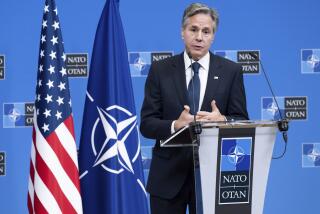NATO Force Vigilant to Protect Europe : Aims to Deter War With Patrols, Military Exercises, Symbolism
- Share via
CORLU, Turkey — When NATO’s multinational Allied Mobile Force deployed to Turkish Thrace on maneuvers recently, the first thing the soldiers did was give blood.
Volunteers among the 5,200 men from the United States, Canada, Britain, West Germany, Italy, Belgium and Luxembourg gave 200 pints of blood, which was donated to an Istanbul hospital for children suffering from thalassemia, a disease of the red blood cells.
The gesture of solidarity with the host nation was symbolic. The mission of the Allied Mobile Force, which celebrated its 25th birthday in October, is to be prepared to shed its blood in defense of the most strategically vulnerable areas on NATO’s flanks.
It aims to deter war by showing potential aggressors that they would confront the whole of the North Atlantic Treaty Organization if they attacked an inch of Allied territory.
“Our presence would ensure that the first blood drawn in any conflict was multinational. An attack on one would indeed be an attack on all,” said Maj. David Emmett, the force’s spokesman.
That role, and the relatively limited combat power of the brigade-size air-mobile task force, have led some analysts to view the force more as hostages than as fighters.
The commanding officer, Canadian Maj. Gen. Andrew Christie, disputed this. “I don’t look at myself and my soldiers as hostages,” he said. “Yes, the force is symbolic . . . but in the spirit of comrades-in-arms, not hostages.”
Six Action Areas
NATO has designated six areas to which the force could be sent in time of East-West tension: eastern Turkey and northern Norway, which border the Soviet Union; the Turkish and Greek frontiers with Bulgaria; northeastern Italy and Denmark’s Baltic islands.
The force trains each year in tough, realistic exercises that test its ability to deploy rapidly to the places it would go in a real crisis--except for Greece, which under Socialist Prime Minister Andreas Papandreou has refused to let the force in.
The decision to dispatch the force would be taken in Brussels by NATO ambassadors in the defense planning council, in conjunction with the country involved. It would almost certainly precede any general mobilization of Western forces.
Most units would be rushed from their home countries, apart from the U.S. contingent, already based in central Europe, and a small permanent headquarters staff in Heidelberg, West Germany.
Member nations contribute crack forces, including Italy’s Alpine brigade, Belgium’s Para-Commando Battalion, the West German Army’s helicopter unit and Britain’s Royal Artillery and the Queen’s Royal Lancers reconnaissance squadron.
In keeping with its deterrence mission, the Allied Mobile Force deliberately keeps a high profile. On arrival, it begins clearly visible “deterrent patrols” and artillery firings to demonstrate its presence to adversary forces and the local population.
Because of the remote areas in which it might operate, the force must be self-sufficient in both sub-zero Arctic conditions and the torrid heat of the eastern Mediterranean.
The logistics support battalion’s multinational workshop faces daunting problems in repairing equipment and vehicles, which are not standardized.
More to Read
Sign up for Essential California
The most important California stories and recommendations in your inbox every morning.
You may occasionally receive promotional content from the Los Angeles Times.













